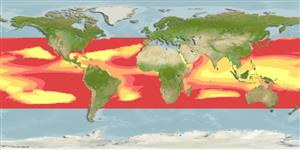>
Syngnathiformes (Pipefishes and seahorses) >
Centriscidae (Snipefishes and shrimpfishes) > Macroramphosinae
Etymology: Macroramphosus: Greek, makros = great + Greek, rhamphos = beak, bill (Ref. 45335).
More on author: Lowe.
Environment: milieu / climate zone / depth range / distribution range
Écologie
marin; profondeur 50 - 500 m (Ref. 58302), usually 50 - 150 m (Ref. 58302). Deep-water; 45°N - 40°S, 180°W - 180°E
Indo-Pacific and Western Central Atlantic: Indo-West-Pacific: Africa through the tropical Pacific to Hawaii and Desventuradas Is. and Juan Fernandez Is. (Ref. 89357). Eastern Central Pacific: California, USA. Western Central Atlantic: Florida, USA and Bahamas to Cuba (Ref. 7251).
Taille / Poids / Âge
Maturity: Lm ? range ? - ? cm
Max length : 15.0 cm TL mâle / non sexé; (Ref. 2850)
Description synthétique
Morphologie | Morphométrie
Épines dorsales (Total): 4 - 7; Rayons mous dorsaux (Total): 10-13; Épines anales 0; Rayons mous anaux: 18 - 19; Vertèbres: 23 - 24. Branchiostegal rays: 4 (Ref. 36710).
Found in a wide range of habitats, from near surface to near bottom and sometimes in huge schools (Ref. 2850). May range into coastal waters (Ref. 36711). Oviparous, with planktonic eggs and larvae (Ref. 36711). Seems to be sympatric with Macroramphosus scolopax (Linnaeus, 1758) all around the world (Ref. 89357).
Life cycle and mating behavior
Maturité | Reproduction | Frai | Œufs | Fécondité | Larves
Robins, C.R. and G.C. Ray, 1986. A field guide to Atlantic coast fishes of North America. Houghton Mifflin Company, Boston, U.S.A. 354 p. (Ref. 7251)
Statut dans la liste rouge de l'IUCN (Ref. 130435)
Menace pour l'homme
Harmless
Utilisations par l'homme
Plus d'informations
RéférencesAquacultureProfil d'aquacultureSouchesGénétiqueElectrophoresesHéritabilitéPathologiesTraitementNutrientsMass conversion
Outils
Articles particuliers
Télécharger en XML
Sources Internet
Estimates based on models
Preferred temperature (Ref.
123201): 11.8 - 26.8, mean 19.7 °C (based on 1175 cells).
Phylogenetic diversity index (Ref.
82804): PD
50 = 0.7502 [Uniqueness, from 0.5 = low to 2.0 = high].
Bayesian length-weight: a=0.01479 (0.00600 - 0.03648), b=2.93 (2.72 - 3.14), in cm total length, based on LWR estimates for this (Sub)family-body shape (Ref.
93245).
Niveau trophique (Ref.
69278): 3.4 ±0.5 se; based on size and trophs of closest relatives
Résilience (Ref.
120179): Milieu, temps minimum de doublement de population : 1,4 à 4,4 années (K=0.55-1.18; tmax=2).
Fishing Vulnerability (Ref.
59153): Low vulnerability (12 of 100).
